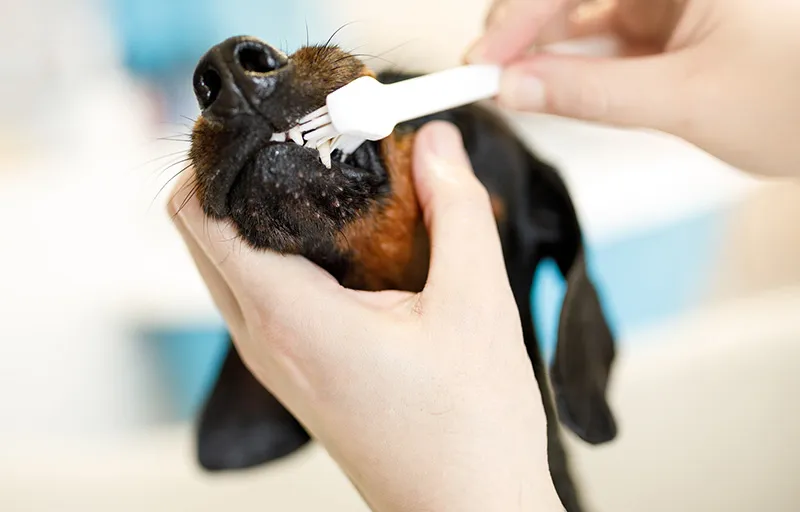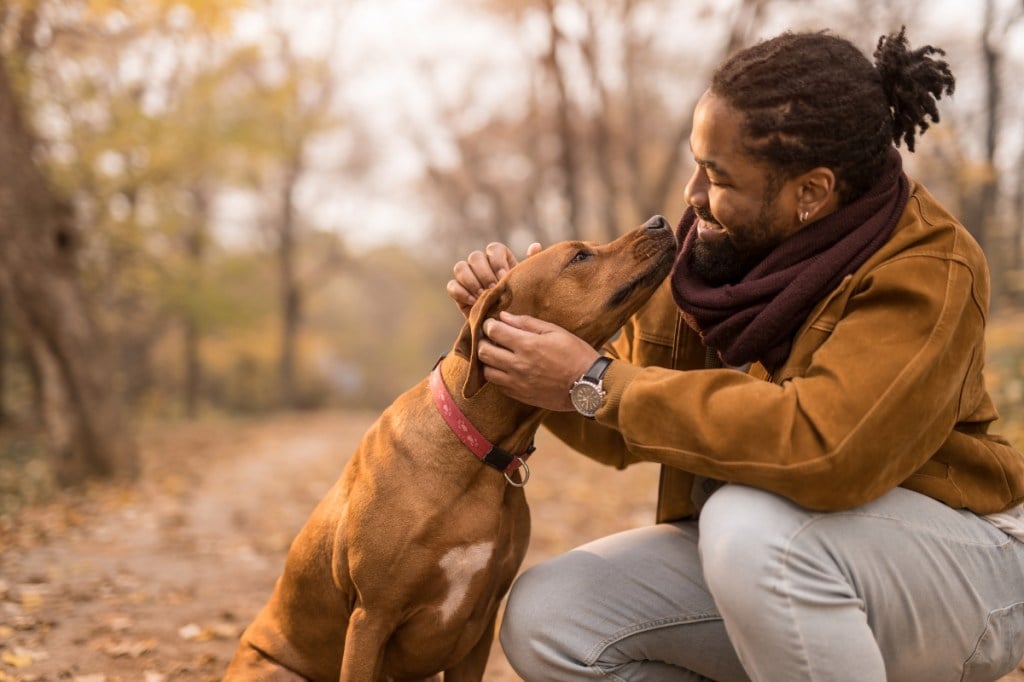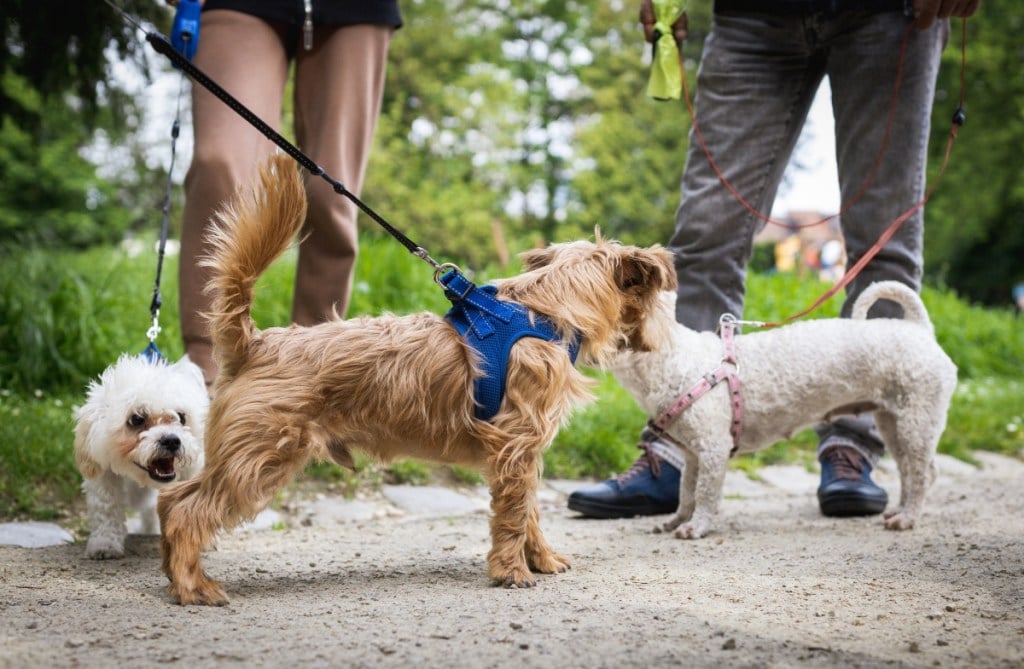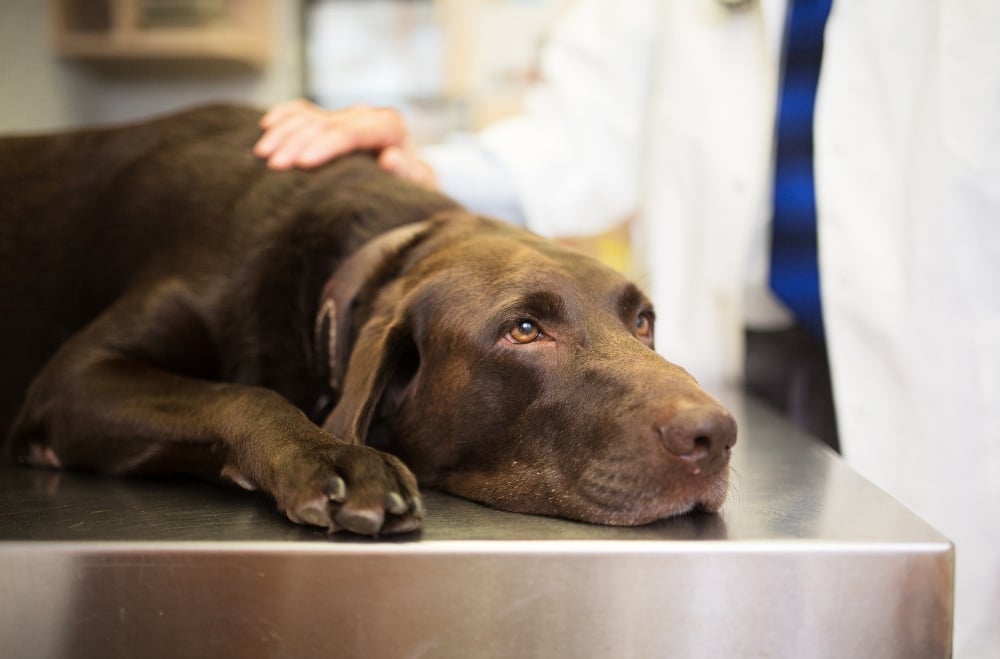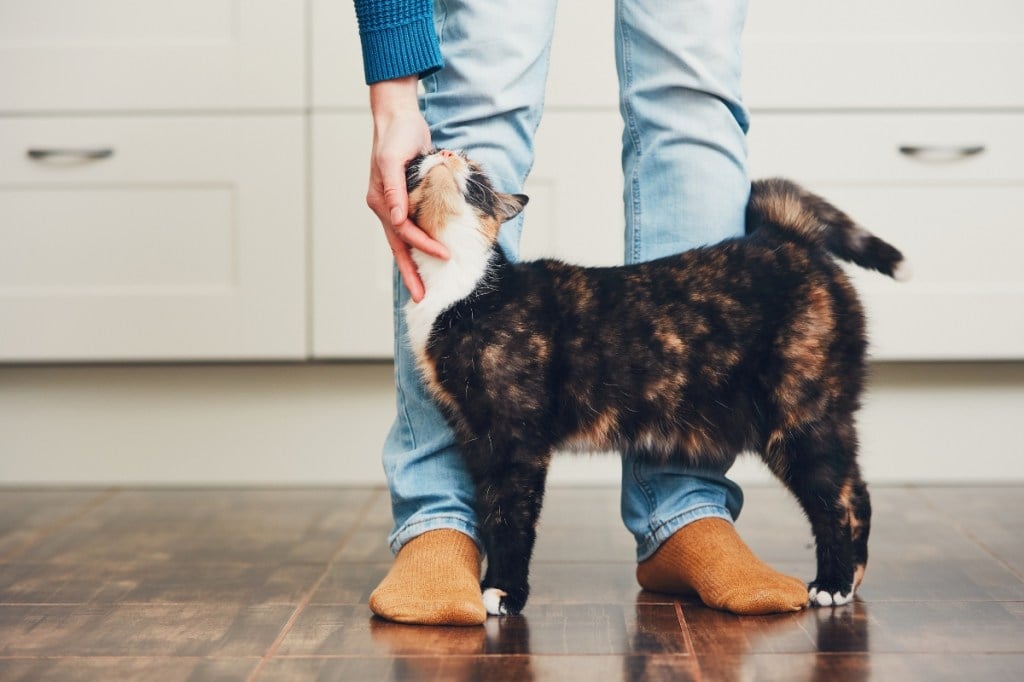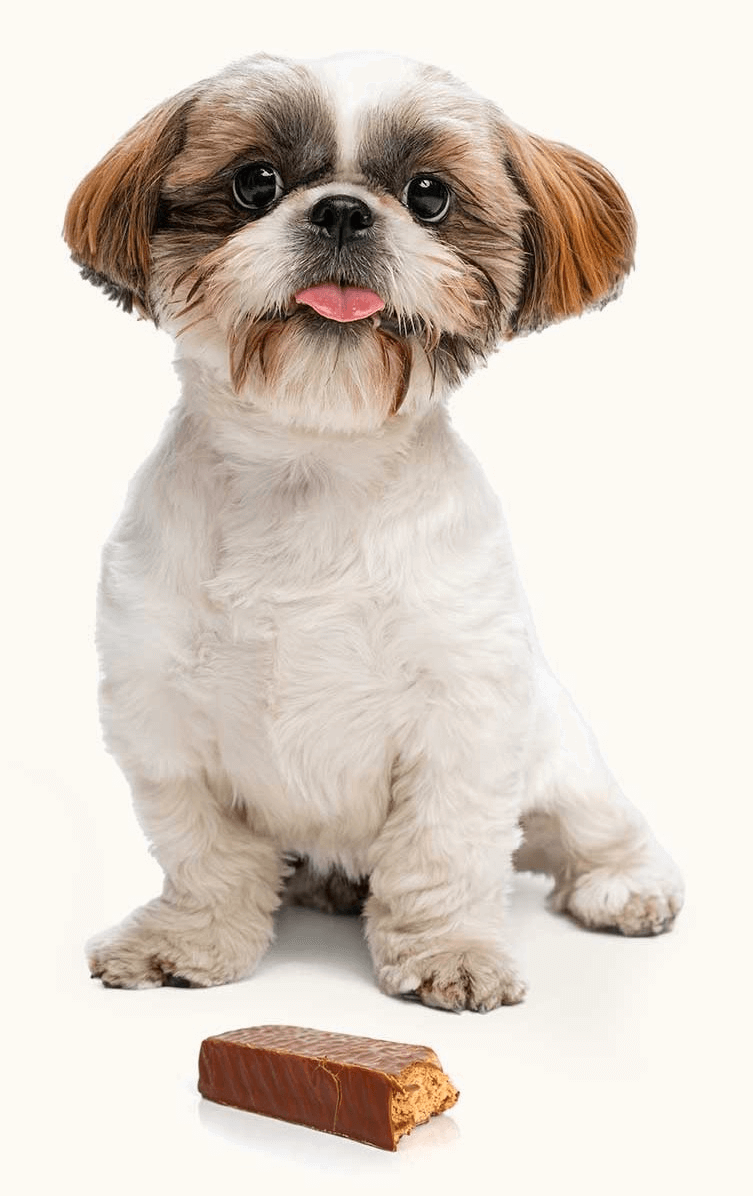Key Takeaways
- Caring for your dog’s teeth is as important as other preventative care, and will keep your pet from developing related health conditions.
- Brushing your dog’s teeth regularly is key to their oral health.
- You can save money and trips to the store by making your own homemade dog toothpaste, with just a few ingredients you may already have on hand.
Table of Contents
If your dog has bad breath, it’s more than just an annoyance when he plants a wet, sloppy kiss on your face. It could be a sign of decay and poor oral health that can be addressed with teeth cleaning.
If your dog has bad breath, it’s more than just an annoyance when he plants a wet, sloppy kiss on your face. It could be a sign of decay and poor oral health that can be addressed with teeth cleaning.
While often neglected, dental health is essential for dogs, especially for seniors. Just like humans, dogs can develop periodontal disease, cavities, and inflammation or ulcers of the mouth. Dental diseases can lead to other conditions that can drastically reduce a dog’s quality of life, which include secondary infections in the blood, a weakened immune system, and susceptibility to disease and illness. At the very least, dental problems can lead to chronic pain and difficulty eating.
And besides hygiene and health benefits, teeth cleaning has the added bonus of giving your dog fresher-smelling breath.
Experts say that we should brush our dog’s teeth once daily. Doing so will remove plaque (the fuzzy film of food debris and bacteria that forms on teeth) before it has a chance to harden into tartar (which is more difficult to remove). If daily brushing seems unrealistic, aim for two or three times a week to keep your pooch’s chompers and gums clean and healthy. Any less than twice a week probably offers minimal benefits.
You can buy toothpaste made specifically for dogs, with ingredients designed to clean your dog’s teeth while also being tasty. Alternatively, you can make homemade dog toothpaste, which is easy, has few ingredients that you may already have on hand, and takes only a few minutes.
Do-It-Yourself toothpaste allows you to avoid additional trips to the store, saves you some money, and makes for an easy home project. It’s also more earth-friendly, as you are reducing the plastic packaging waste and shipping emissions that come with store-bought brands.
Whatever you do, don’t use human toothpaste for your dog. It may contain ingredients that are toxic to dogs.
Ingredients you can use in homemade dog toothpaste:
- Coconut oil
- Flavorings such as beef or chicken bouillon, mint, parsley, cinnamon, cloves or peanut butter
- Kelp
- Turmeric
- Baking soda (maybe – see below)
Ingredients to avoid in dog toothpaste
First, you should never brush your dog’s teeth with human toothpaste, which contains some ingredients that are not healthy for dogs. Nor should you put these substances in your pet’s toothpaste, according to Hill’s Pet Nutrition.
- Fluoride: While commonly added to human toothpaste, fluoride can be toxic to pets if swallowed.
- Xylitol: An artificial sweetener in many human products such as gum, candy and peanut butter, xylitol is highly toxic to dogs and can cause death. Read labels carefully to make sure no xylitol gets into your toothpaste.
What about baking soda?
There is some disagreement in the veterinary community about whether it is acceptable to add baking soda to toothpaste. VCA Animal Hospitals discourage its use because dogs generally dislike the taste. Additionally, this common household item can be toxic in large quantities.
However, some homemade recipes and some commercially made toothpastes for dogs contain baking soda for its abrasiveness and plaque-preventing qualities. Additionally, the amount of baking soda used in toothpaste is typically too small to cause toxicity. A dog would have to consume at least one teaspoon per pound of body weight for the substance to become dangerous, according to the American College of Veterinary Pharmacists. Even so, if your dog shows any signs of toxicity after using toothpaste with baking soda – vomiting, diarrhea, lethargy, tremors or seizures – discontinue use immediately and seek out treatment from a vet.
In reality, the primary benefit of brushing is associated with the mechanical action of brushing. It’s the toothbrush bristles that remove plaque, not the toothpaste itself. In fact, you could gain many of the benefits of brushing simply by using a toothbrush that has been moistened with water. Toothpaste is mainly there to improve the taste for your pet (which makes brushing more enjoyable) and add lubrication.
We’ve included some recipes with baking soda and one without.
Six toothpaste recipes for dogs
Toothpaste Recipe with coconut oil from K9 Instinct
Ingredients:
- 1 cup of unrefined, virgin coconut oil
- 1/2 teaspoon of turmeric
- 1/2 teaspoon of kelp
- 1/8 tablespoon of dried parsley flakes
Directions:
- Place one cup of coconut oil in a hot water bath to make it soft and pliable.
- Add the turmeric, kelp and parsley flakes.
- Mix thoroughly, store in fridge between uses.
Natural toothpaste for dogs, no coconut oil from Organic Authority
Ingredients:
- 6 tablespoons baking soda
- ½ teaspoon salt
- 1 cube of beef bouillon (or vegetable for a vegan version)
- 1 teaspoon dried or fresh parsley
- 1 teaspoon water
Directions:
- Mix all the ingredients together thoroughly in a small bowl, adding a bit more water if necessary, to make a paste.
- Store in an airtight container.
Four-ingredient homemade toothpaste from Dog Notebook
Ingredients:
- 1 cube of beef bouillon
- Water
- Baking soda
- Cinnamon oil
Directions:
- Take one regular size mixing bowl and dissolve one bouillon cube in the water.
- Add some baking soda to the bouillon and stir. You can also add cinnamon.
- Add some coconut oil to the mixing bowl and continue stirring until the mixture is even.
- Store your doggy toothpaste in a small resealable container for storage. It does not need to be refrigerated.
Homemade toothpaste with mint leaves from Live. Pant. Play
Ingredients:
- 1/4 cup coconut oil
- 1 tsp. cinnamon
- 1 cube of chicken or beef bullion
- 3 Tbsp. baking soda
- 6-7 mint leaves
Directions:
Measure out the ingredients into your blender and blend until the mint leaves are thoroughly chopped and everything is mixed nicely. Put your toothpaste into an air-tight container and store in your fridge.
Toothpaste with cloves from alidoesitherself.com
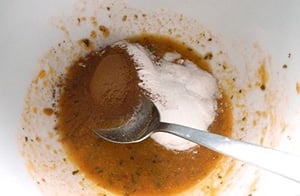
Ingredients:
- 1 Tbsp. water
- 1/2 cup coconut oil
- 1 tsp. cinnamon
- 1 cube of chicken, beef, poultry or veggie bullion
- 2 Tbsp. baking soda
- 1 tsp. dried parsley
- Pinch of ground cloves
Directions:
- Dissolve bouillon cube in the 1 tablespoon water.
- Add in 2 tablespoons baking soda(a deodorizing abrasive), and 1 teaspoon cinnamon (a fragrant abrasive).
- Ground up about 1 teaspoon dried parsley (for fresh breath) and add a pinch of ground cloves (an anti-parasitic).
- Then you need to work in about 1/2 cup coconut oil. If you have trouble mixing everything up you can soften the oil or melt it, but you want it to be solid in the end. Store in a sealed container at room temperature.
Dog toothpaste with peanut butter by Pinterest user Becky Perigo Davis
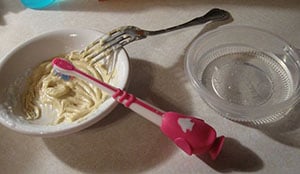
Ingredients:
- 1/2 tsp. Water or 1-1/2 tsp of a dental gel such as Maxi/Guard
- 1 Tbsp. baking soda
- A small amount of peanut butter
Directions:
Add 1 tablespoon of baking soda to a small bowl, then add a pea-size amount of peanut butter. If you are using water, add about 1/2 a teaspoon, if you are using a dental gel such as Maxi/Guard, use about 1-1/2 teaspoons. Add your liquid and mix well until the mixture has a paste consistency. Store in a sealed container.
Best dog toothpaste to buy
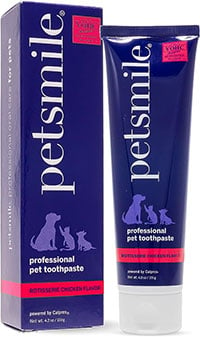
If you’d rather just buy some toothpaste for your dog, there are many options available. Look for brands with enzymes, which help fight plaque and bad breath, and a flavor your dog will like. Two brands are endorsed by the Veterinary Oral Health Council — Petsmile Toothpaste and healthymouth Dog Topical Gel.
- Petsmile Toothpaste contains human-grade calcium peroxide and minerals, which the company says works by gently dissolving the biofilm that forms on your pets’ teeth. “It really works! Petsmile Toothpaste exceeded my expectations in terms of effectiveness, convenience, and pet-friendly ingredients,” one Amazon reviewer said. Cost: $20 for a four-month supply.
- Healthymouth™ Dog Topical Gel. While it’s a gel rather than a paste, this product gets high marks for treating dogs with inflammation and gum problems. It can be used on its own, applied to the teeth and gums daily after brushing, or in conjunction with a water additive for pets with more problematic teeth and gums. It comes with applicator wands. Cost: $68
Here are some dog toothpaste on Chewy.com and Amazon that customers rate as the best.
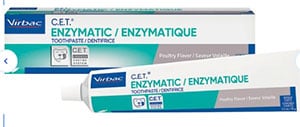
- Virbac C.E.T. Enzymatic Dog & Cat Poultry Flavor Toothpaste
An enzymatic toothpaste specifically formulated to be safe, effective, and appealing to your pet. “I get the poultry flavor of this stuff, and my pups love it! In particular, my dachshund follows me to the bathroom when I brush my teeth and will sit by me and wait for her turn. Highly recommend!,” one reviewer wrote. Cost: $9.44 for 70 grams. - Sentry Petrodex Veterinary Strength Enzymatic Dog Toothpaste
The company says the toothpaste controls plaque and tartar with regular use and contains ingredients that freshen breath while cleaning teeth. “My dog loves this toothpaste; he hasn’t liked any toothpaste we have purchased in the past. We will continue to buy,” a reviewer wrote. Cost: $9.12 for 6.2 oz.
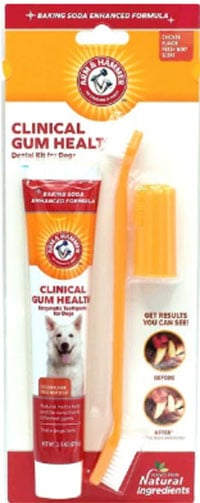
- Arm & Hammer Dental Clinical Gum Health Dog Toothpaste & Brush Kit
An enzymatic toothpaste made with baking soda and natural ingredients like natural herbs to help soothe sensitive and inflamed gums. The kit comes with a finger brush so you can massage your pet’s gums and help scrub away grime. “My dog really likes it. Can use either the thumb device or the toothbrush that was provided, all at a good price,” one customer wrote. Cost: $2.39 - RADIUS – Organic Dental Solutions Adult, Natural Dog Toothgel and Toothbrush
This U.S.-made, certified organic gel contains a blend of sweet potato and coconut oil, which help fight plaque and prevent cavities. “Great, clean ingredients. Smells good. Toothbrush is small but good and easy to use. My dog is used to getting his teeth brushed nevertheless he didn’t mind this one at all. Good stuff!,” a reviewer wrote. Cost: $12.59 for brush and .08 oz gel.
Select a pet toothbrush
There are many different styles of dog toothbrushes. Some have angled heads for easier brushing, while others are rubbery and fit on a fingertip.
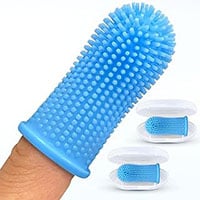
Look for a toothbrush that fits the size of your dog’s mouth and ensure the bristles are soft. There are specific toothbrushes for dogs on the market, but a regular human or child-size brush should work just fine. The Veterinary Oral Health Council recommends using a dog toothbrush that has rounded bristles, to avoid irritating gums. If you don’t mind putting your fingers in your dog’s mouth, and your dog will tolerate it, a finger brush or a simple piece of gauze around the finger is a good option.
How to brush your dog’s teeth
OK, so you’ve committed to making or buying some dog toothpaste, and you are ready to start brushing. Healthy Paws has some advice on how to brush your dog’s teeth. At first, brushing a dog’s teeth can be mildly stressful and confusing for the animal. But the more you do it, the quicker your pet will become comfortable with you cleaning his teeth.
Here is a brief overview:
- Ease into it: Before you stick a strange object into your dog’s mouth, start by petting the muzzle and lips, allowing your dog to get used to the sensation of you handling the area. Work up to rubbing a towel or piece of cloth on the teeth, mimicking the brushing motion. Finally, give your pup a taste of doggy toothpaste. If your dog seems to accept both the simulated brushing and the toothpaste, it’s time to move on to the next step.
- Begin brushing: Now introduce the dog toothbrush, applying a pea-sized amount of toothpaste. Gently raise your dog’s lips out of the way – this is the part where most pets struggle. Brushing in circular motions, focus on the outside of your dog’s teeth and around the canines; these areas are hot spots for periodontal disease. For the first few tooth brushing sessions, you may not be able to get all his teeth. Work up to it over several weeks – a forced brushing can make a dog anxious.
- Do you need to rinse after brushing? You don’t need to rinse after brushing if your dog seems OK with the taste of the toothpaste. A dog won’t know to spit it out anyway. If they don’t enjoy the paste in their mouth, you can squirt some water in to help clear the taste.
Get a professional cleaning regularly too
Just like humans, your vet may recommend professional teeth cleaning for your pooch, usually with general anesthesia. They’ll remove tartar and plaque and recommend further dental procedures if they find problems.
However, because anesthesia is required, dog teeth cleaning is pretty pricey – and not covered by pet insurance. Consider budgeting for an annual cleaning, especially if your pup has a history of dental problems. The cost of cleaning dogs’ teeth can be up to $500 depending on your city as well as the age and weight of your dog.
How else can I keep my dog’s teeth clean?
In addition to brushing your dog’s teeth, there are many other ways to maintain his dental health. Foods, treats, toys, chews, water additives, and oral sprays are all available to promote a healthy mouth. Greenies dental treats are a favorite among pet parents and dogs and are VOHC certified. For hardcore chewers, Purina’s HeartyHide and PPVD rawhide treats fight tartar on teeth.
If your pup has recurring problems, ask your vet about a prescription dog food specifically for dental health. These diets are designed to work as a toothbrush, mechanically cleaning your dog’s teeth with each bite.
While routine dental care is not covered by pet insurance, most illnesses and accidents are, and can save you as much as 90 percent on vet bills. Find out more about dog insurance (and cat insurance) and start by getting a dog insurance quote. Bonus: Each quote means a donation is made to homeless pets.
